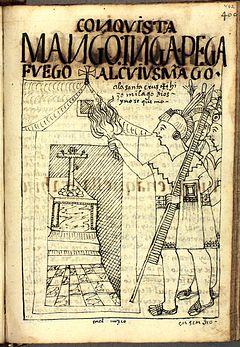Siege of Cuzco
| Siege of Cuzco | ||||||||
|---|---|---|---|---|---|---|---|---|
| Part of Spanish conquest of Peru | ||||||||
 The siege of Cuzco according to Felipe Guaman Poma de Ayala |
||||||||
|
||||||||
| Belligerents | ||||||||
|
|
|
|||||||
| Commanders and leaders | ||||||||
|
Hernando Pizarro (POW) Gonzalo Pizarro (POW) Juan Pizarro II † Francisco Pizarro |
Diego de Almagro Rodrigo Orgóñez |
Manco Inca Yupanqui Cahuide† |
||||||
| Strength | ||||||||
| 30,000 Indios auxiliares 190 Spaniards Later +300 Spaniards under F. Pizarro |
700 Spaniards (as for early 1537) | 100,000 to 200,000 Inca warriors | ||||||
| Casualties and losses | ||||||||
| Unknown | Unknown, but low | Unknown | ||||||
![]() Spanish Empire
Spanish Empire
Pizarro brothers
Native allies
The Siege of Cuzco (May 6, 1536 – March 1537) was the siege of the city of Cusco by the army of Sapa Inca Manco Inca Yupanqui against a garrison of Spanish conquistadors and Indian auxiliaries led by Hernando Pizarro in the hope to restore the Inca Empire (1438-1533). The siege lasted ten months and was ultimately unsuccessful.
A Spanish expedition led by Francisco Pizarro had captured the Inca capital of Cusco on November 15, 1533 after defeating an Inca army headed by general Quisquis. The following month, the conquistadors supported the coronation of Manco Inca as Inca emperor to facilitate their control over the empire. Real power rested with the Spaniards who frequently humiliated Manco Inca and imprisoned him after an attempted escape in November 1535. After his release in January 1536, Manco Inca left Cusco on April 18 promising the Spanish commander, Hernando Pizarro, to bring back a large gold statue when in fact he was already preparing a rebellion.
Having realized their mistake, Hernando Pizarro led an expedition against Manco Inca's troops, which had gathered in the nearby Yucay Valley; the attack failed as the Spaniards had severely underestimated the size of the Inca army. The Inca emperor did not attack Cusco at once, instead he waited to assemble his full army estimated at between 100,000 and 200,000 men strong around the city (some sources suggest numbers as low as 40,000); against them there were 190 Spaniards, 80 of them horsemen, and several thousand Indian auxiliaries. The siege started on May 6, 1536 with a full-scale attack towards the main square of the city; the Inca army succeeded in capturing most of the city while the Spaniards took refuge in two large buildings near the main plaza. The conquistadors fended off Inca attacks from these constructions and mounted frequent raids against their besiegers.
...
Wikipedia
